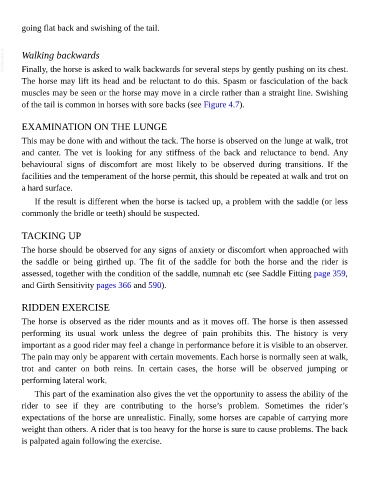Page 542 - The Veterinary Care of the Horse
P. 542
going flat back and swishing of the tail.
VetBooks.ir Walking backwards
Finally, the horse is asked to walk backwards for several steps by gently pushing on its chest.
The horse may lift its head and be reluctant to do this. Spasm or fasciculation of the back
muscles may be seen or the horse may move in a circle rather than a straight line. Swishing
of the tail is common in horses with sore backs (see Figure 4.7).
EXAMINATION ON THE LUNGE
This may be done with and without the tack. The horse is observed on the lunge at walk, trot
and canter. The vet is looking for any stiffness of the back and reluctance to bend. Any
behavioural signs of discomfort are most likely to be observed during transitions. If the
facilities and the temperament of the horse permit, this should be repeated at walk and trot on
a hard surface.
If the result is different when the horse is tacked up, a problem with the saddle (or less
commonly the bridle or teeth) should be suspected.
TACKING UP
The horse should be observed for any signs of anxiety or discomfort when approached with
the saddle or being girthed up. The fit of the saddle for both the horse and the rider is
assessed, together with the condition of the saddle, numnah etc (see Saddle Fitting page 359,
and Girth Sensitivity pages 366 and 590).
RIDDEN EXERCISE
The horse is observed as the rider mounts and as it moves off. The horse is then assessed
performing its usual work unless the degree of pain prohibits this. The history is very
important as a good rider may feel a change in performance before it is visible to an observer.
The pain may only be apparent with certain movements. Each horse is normally seen at walk,
trot and canter on both reins. In certain cases, the horse will be observed jumping or
performing lateral work.
This part of the examination also gives the vet the opportunity to assess the ability of the
rider to see if they are contributing to the horse’s problem. Sometimes the rider’s
expectations of the horse are unrealistic. Finally, some horses are capable of carrying more
weight than others. A rider that is too heavy for the horse is sure to cause problems. The back
is palpated again following the exercise.

